Assessing the Rainfall Water Harvesting Potential Using Geographical Information Systems (GIS)
Abstract
1. Introduction
2. Materials and Methods
2.1. Study Area
2.2. Methodology
2.2.1. Water Harvesting from Rooftop
2.2.2. Water Harvesting from Rooftop
3. Results and Discussion
4. Conclusions
- A significant amount of highly valued water is usually lost from rooftops and direct runoff after each rainfall event.
- The water required to irrigate trees and plants on the campus is 125,125 ft3 per month, which exceeds the irrigation requirements. Water can be conserved by proper planning to harvest rainfall from rooftop areas and this water can be used for agriculture, domestic, or drinking purposes. In this study, it was calculated that we could save 74,050.34 ft3 of water per month by using a rooftop harvesting system on the campus, which can be used as an additional source of water for irrigation purposes. In this way, 59% of the current water used for this purpose could be harvested.
- Water can also be conserved by installing recharge wells at proper locations in the area, and after recharging water to the deeper layers, the groundwater table will rise. In this study, it is calculated that by installing recharge wells at suitable locations, we can use 761,400 ft3/year of water for groundwater development.
Author Contributions
Funding
Data Availability Statement
Conflicts of Interest
References
- Zhu, Q.; Gould, J. Rainwater harvesting irrigation—A strategic measure for integrated rural development in the dry mountainous areas of Gansu province, China. In Rainwater-Smart Agriculture in Arid and Semi-Arid Areas; Springer: Cham, Switzerland, 2018; pp. 235–257. [Google Scholar] [CrossRef]
- Helmreich, B.; Harald, H. Opportunities in rainwater harvesting. Desalination 2009, 248, 118–124. [Google Scholar] [CrossRef]
- Latif, S.; Alim, M.A.; Rahman, A. Disinfection methods for domestic rainwater harvesting systems: A scoping review. J. Water Process Eng. 2022, 46, 102542. [Google Scholar] [CrossRef]
- Yang, Y.; Javanroodi, K.; Nik, V.M. Climate Change and Renewable Energy Generation in Europe—Long-Term Impact Assessment on Solar and Wind Energy Using High-Resolution Future Climate Data and Considering Climate Uncertainties. Energies 2022, 15, 302. [Google Scholar] [CrossRef]
- Morris, B.L.; Lawrence, A.R.L.; Chilton, P.J.C.; Adams, B.; Calow, R.C.; Klinck, B.A. Groundwater and its Susceptibility to Degradation: A Global Assessment of the Problem and Options for Management; Early Warning and Assessment Report Series; RS. 03-3; United Nations Environment Programme: Nairobi, Kenya, 2003. [Google Scholar]
- Nawaz, A.; Shah SA, R.; Su, X.; Dar, A.A.; Qin, Z.; Albasher, G. Analytical strategies to sense water stress level: An analysis of ground water fluctuations sensing SDGs under pandemic scenario. Chemosphere 2022, 291, 132924. [Google Scholar] [CrossRef] [PubMed]
- Wada, Y.; Bierkens, M.F. Sustainability of global water use: Past reconstruction and future projections. Environ. Res. Lett. 2014, 9, 104003. [Google Scholar] [CrossRef]
- Laghari, A.; Vanham, D.; Rauch, W. The Indus basin in the framework of current and future water resources management. Hydrol. Earth Syst. Sci. 2012, 16, 1063–1083. [Google Scholar] [CrossRef]
- Island, P.E. Application of numerical modeling to groundwater assessment and management in Prince Edward Island. In Proceedings of the 2004 57th Canadian Geotechnical Conference, Québec, QC, Canada, 25–27 October 2004. [Google Scholar]
- Qureshi, A.S. Groundwater governance in Pakistan: From colossal development to neglected management. Water 2020, 12, 3017. [Google Scholar] [CrossRef]
- Qureshi, A.S.; Gill, M.A.; Sarwar, A. Sustainable groundwater management in Pakistan: Challenges and opportunities. Irrigation and Drainage. J. Int. Comm. Irrig. Drain. 2010, 59, 107–116. [Google Scholar] [CrossRef]
- Khan, S.; Rana, T.; Gabriel, H.; Ullah, M.K. Hydrogeologic assessment of escalating groundwater exploitation in the Indus Basin, Pakistan. Hydrogeol. J. 2008, 16, 1635–1654. [Google Scholar] [CrossRef]
- Wada, Y.; Van Beek, L.P.; Van Kempen, C.M.; Reckman, J.W.; Vasak, S.; Bierkens, M.F. Global depletion of groundwater resources. J. Water Resour. Prot. 2010, 1, 37. [Google Scholar] [CrossRef]
- Walsh, C.J.; Fletcher, T.D.; Burns, M.J. Urban stormwater runoff: A new class of environmental flow problem. PLoS ONE 2012, 7, e45814. [Google Scholar] [CrossRef]
- Mikkelsen, P.; Adeler, O.; Albrechtsen, H.-J.; Henze, M. Collected rainfall as a water source in Danish households-what is the potential and what are the costs? Water Sci. Technol. 2016, 39, 49–56. [Google Scholar] [CrossRef]
- Melville-Shreeve, P.; Ward, S.; Butler, D. Rainwater harvesting typologies for UK houses: A multi-criteria analysis of system configurations. Water 2016, 8, 129. [Google Scholar] [CrossRef]
- Mugume, S.N.; Melville-Shreeve, P.; Gomez, D.; Butler, D. Multifunctional urban flood resilience enhancement strategies. In Proceedings of the Institution of Civil Engineers-Water Management; Thomas Telford Ltd.: London, UK, 2016; Volume 170, pp. 115–127. [Google Scholar]
- Teston, A.; Piccinini Scolaro, T.; Kuntz Maykot, J.; Ghisi, E. Comprehensive Environmental Assessment of Rainwater Harvesting Systems: A Literature Review. Water 2022, 14, 2716. [Google Scholar] [CrossRef]
- Burns, M.J.; Schubert, J.E.; Fletcher, T.D.; Sanders, B.F. Testing the impact of source stormwater management on urban flooding through a coupling of network and overland flow models. Wiley Interdiscip. Rev. Water 2015, 2, 291–300. [Google Scholar] [CrossRef]
- Batalini de Macedo, M.; Nobrega Gomes Junior, M.; Pereira de Oliveira, T.R.; HGiacomoni, M.; Imani, M.; Zhang, K.; Mendiondo, E.M. Low Impact Development practices in the context of United Nations Sustainable Development Goals: A new concept, lessons learned and challenges. Crit. Rev. Environ. Sci. Technol. 2022, 52, 2538–2581. [Google Scholar] [CrossRef]
- DeBusk, K.; Hunt, W.; Wright, J. Characterizing rainwater harvesting performance and demonstrating stormwater management benefits in the humid southeast USA. JAWRA J. Am. Water Resour. Assoc. 2013, 49, 1398–1411. [Google Scholar] [CrossRef]
- Zhang, Y.; Chen, D.; Chen, L.; Ashbolt, S. Potential for rainwater use in high-rise buildings in Australian cities. J. Environ. Manag. 2009, 91, 222–226. [Google Scholar] [CrossRef]
- Barron, J. Background: The water component of ecosystem services and in human well-being development targets. In Rainwater Harvesting: A Lifeline for Human Well-Being; UNEP/Earthprint: Nairobi, Kenya, 2009. [Google Scholar]
- Dile, Y.T.; Karlberg, L.; Temesgen, M.; Rockström, J. The role of water harvesting to achieve sustainable agricultural intensification and resilience against water related shocks in sub-Saharan Africa. Agric. Ecosyst. Environ. 2013, 181, 69–79. [Google Scholar] [CrossRef]
- Rockström, J.; Falkenmark, M. Agriculture: Increase water harvesting in Africa. Nature 2015, 519, 283–285. [Google Scholar] [CrossRef]
- Fernandes, L.F.S.; Terêncio, D.P.; Pacheco, F.A. Rainwater harvesting systems for low demanding applications. Sci. Total Environ. 2015, 529, 91–100. [Google Scholar] [CrossRef] [PubMed]
- Vohland, K.; Barry, B. A review of in situ rainwater harvesting (RWH) practices modifying landscape functions in African drylands. Agric. Ecosyst. Environ. 2009, 131, 119–127. [Google Scholar] [CrossRef]
- Xu, W.D.; Fletcher, T.D.; Duncan, H.P.; Bergmann, D.J.; Breman, J.; Burns, M.J. Improving the Multi-Objective Performance of Rainwater Harvesting Systems Using Real-Time Control Technology. Water 2018, 10, 147. [Google Scholar] [CrossRef]
- Ghayoumian, J.; Ghermezcheshme, B.; Feiznia, S.; Noroozi, A.A. Integrating GIS and DSS for identification of suitable areas for artificial recharge, case study Meimeh Basin, Isfahan, Iran. Environ. Geol. 2005, 47, 493–500. [Google Scholar] [CrossRef]
- Al Saud, M. Mapping potential areas for groundwater storage in Wadi Aurnah Basin, western Arabian Peninsula, using remote sensing and geographic information system techniques. Hydrogeol. J. 2010, 18, 1481–1495. [Google Scholar] [CrossRef]
- Chenini, I.; Mammou, A.B.; El May, M. Groundwater recharge zone mapping using GIS-based multi-criteria analysis: A case study in Central Tunisia (Maknassy Basin). Water Resour. Manag. 2010, 24, 921–939. [Google Scholar] [CrossRef]
- Machiwal, D.; Jha, M.K.; Mal, B.C. Assessment of groundwater potential in a semi-arid region of India using remote sensing, GIS and MCDM techniques. Water Resour. Manag. 2011, 25, 1359–1386. [Google Scholar] [CrossRef]
- Malekmohammadi, B.; Mehrian, M.R.; Jafari, H.R. Site selection for managed aquifer recharge using fuzzy rules: Integrating geographical information system (GIS) tools and multi-criteria decision making. Hydrogeol. J. 2012, 20, 1393–1405. [Google Scholar] [CrossRef]
- Hammouri, N.; Al-Amoush, H.; Al-Raggad, M.; Harahsheh, S. Groundwater recharge zones mapping using GIS: A case study in Southern part of Jordan Valley, Jordan. Arab. J. Geosci. 2014, 7, 2815–2829. [Google Scholar] [CrossRef]
- Fewkes, A. A review of rainwater harvesting in the UK. Struct. Surv. 2012, 30, 174–194. [Google Scholar] [CrossRef]
- Kahinda, J.M.; Taigbenu, A.E.; Boroto, J.R. Domestic rainwater harvesting to improve water supply in rural South Africa. Phys. Chem. Earth Parts A/B/C 2007, 32, 1050–1057. [Google Scholar] [CrossRef]
- Lee, K.E.; Mokhtar, M.; Hanafiah, M.M.; Halim, A.A.; Badusah, J. Rainwater harvesting as an alternative water resource in Malaysia: Potential, policies and development. J. Clean. Prod. 2016, 126, 218–222. [Google Scholar] [CrossRef]
- Kakoulas, D.A.; Golfinopoulos, S.K.; Koumparou, D.; Alexakis, D.E. The Effectiveness of Rainwater Harvesting Infrastructure in a Mediterranean Island. Water 2022, 14, 716. [Google Scholar] [CrossRef]
- Lopez Mendez, B.; Huhn, L. Literature Review on Managed Aquifer Recharge in the Context of Water and Soil Restoration Methods; Abwasserwirtschaft und Gewässerschutz B-2: Hamburg, Germany. [CrossRef]
- Rahman, A.; Keane, J.; Imteaz, M.A. Rainwater harvesting in Greater Sydney: Water savings, reliability and economic benefits. Resour. Conserv. Recycl. 2012, 61, 16–21. [Google Scholar] [CrossRef]
- Sharma, B.; Amarasinghe, U.; Xueliang, C.; de Condappa, D.; Shah, T.; Mukherji, A.; Bharati, L.; Ambili, G.; Qureshi, A.; Pant, D.; et al. The Indus and the Ganges: River basins under extreme pressure. In Water, Food and Poverty in River Basins; Routledge: Oxfordshire, UK, 2013; pp. 40–68. [Google Scholar] [CrossRef]
- Archer, D.R.; Forsythe, N.; Fowler, H.J.; Shah, S.M. Sustainability of water resources management in the Indus Basin under changing climatic and socio economic conditions. Hydrol. Earth Syst. Sci. 2010, 14, 1669–1680. [Google Scholar] [CrossRef]
- Kazmi, S.I.; Ertsen, M.W.; Asi, M.R. The impact of conjunctive use of canal and tube well water in Lagar irrigated area, Pakistan. Phys. Chem. Earth Parts A/B/C 2012, 47, 86–98. [Google Scholar] [CrossRef]
- Watto, M.A.; Mugera, A.W. Groundwater depletion in the Indus Plains of Pakistan: Imperatives, repercussions and management issues. Int. J. River Basin Manag. 2016, 14, 447–458. [Google Scholar] [CrossRef]
- Humphreys, E.; Kukal, S.S.; Christen, E.W.; Hira, G.S.; Sharma, R.K. Halting the groundwater decline in north-west India—which crop technologies will be winners? Adv. Agron. 2010, 109, 155–217. [Google Scholar] [CrossRef]
- DeBusk, K.M.; Hunt, W.F.; Wright, J.D. Characterization of rainwater harvesting utilization in humid regions of the United States. J. Am. Water Resour. Assoc. 2013, 49, 1398–1411. [Google Scholar] [CrossRef]
- Collins, R. Effectiveness of domestic rainwater tanks. Water J. Aust. Water Assoc. 2008, 35, 116–120. [Google Scholar]
- Burns, M.J.; Fletcher, T.D.; Duncan, H.P.; Hatt, B.E.; Ladson, A.R.; Walsh, C.J. The performance of rainwater tanks for stormwater retention and water supply at the household scale: An empirical study. Hydrol. Processes 2015, 29, 152–160. [Google Scholar] [CrossRef]
- Heyworth, J.S.; Glonek, G.; Maynard, E.J.; Baghurst, P.A.; Finlay-Jones, J. Consumption of untreated tank rainwater and gastroenteritis among young children in South Australia. Int. J. Epidemiol. 2006, 35, 1051–1058. [Google Scholar] [CrossRef]
- Campisano, A.; Modica, C. Rainwater harvesting as source control option to reduce roof runoff peaks to downstream drainage systems. J. Hydroinform. 2015, 18, 23–32. [Google Scholar] [CrossRef]
- Haque, M.M.; Rahman, A.; Samali, B. Evaluation of climate change impacts on rainwater harvesting. J. Clean. Prod. 2016, 137, 60–69. [Google Scholar] [CrossRef]
- Yannopoulos, S.; Giannopoulou, I.; Kaiafa-Saropoulou, M. Investigation of the current situation and prospects for the development of rainwater harvesting as a tool to confront water scarcity worldwide. Water 2019, 11, 2168. [Google Scholar] [CrossRef]
- Vialle, C.; Busset, G.; Tanfin, L.; Montrejaud-Vignoles, M.; Huau, M.C.; Sablayrolles, C. Environmental analysis of a domestic rainwater harvesting system: A case study in France. Resour. Conserv. Recycl. 2015, 102, 178–184. [Google Scholar] [CrossRef]
- Abdulla, F.A.; Al-Shareef, A.W. Roof rainwater harvesting systems for household water supply in Jordan. Desalination 2009, 243, 195–207. [Google Scholar] [CrossRef]
- Gado, T.A.; El-Agha, D.E. Feasibility of rainwater harvesting for sustainable water management in urban areas of Egypt. Environ. Sci. Pollut. Res. 2020, 27, 32304–32317. [Google Scholar] [CrossRef]
- Herrmann, T.; Schmida, U. Rainwater utilisation in Germany: Efficiency, dimensioning, hydraulic and environmental aspects. Urban Water 2000, 1, 307–316. [Google Scholar] [CrossRef]
- Domènech, L.; Saurí, D. A comparative appraisal of the use of rainwater harvesting in single and multi-family buildings of the Metropolitan Area of Barcelona (Spain): Social experience, drinking water savings and economic costs. J. Clean. Prod. 2011, 19, 598–608. [Google Scholar] [CrossRef]
- Ghisi, E.; Bressan, D.L.; Martini, M. Rainwater tank capacity and potential for potable water savings by using rainwater in the residential sector of southeastern Brazil. Build. Environ. 2007, 42, 1654–1666. [Google Scholar] [CrossRef]
- Vieira, A.S.; Ghisi, E. Water-energy nexus in low-income houses in Brazil: The influence of integrated on-site water and sewage management strategies on the energy consumption of water and sewerage services. J. Clean. Prod. 2016, 133, 145–162. [Google Scholar] [CrossRef]
- Ghisi, E.; Ferreira, D.F. Potential for potable water savings by using rainwater and greywater in a multi-storey residential building in southern Brazil. Build. Environ. 2007, 42, 2512–2522. [Google Scholar] [CrossRef]
- Freni, G.; Liuzzo, L. Effectiveness of Rainwater Harvesting Systems for Flood Reduction in Residential Urban Areas. Water 2019, 11, 1389. [Google Scholar] [CrossRef]
- Available online: www.greenmetric.ui.ac.id (accessed on 3 January 2021).

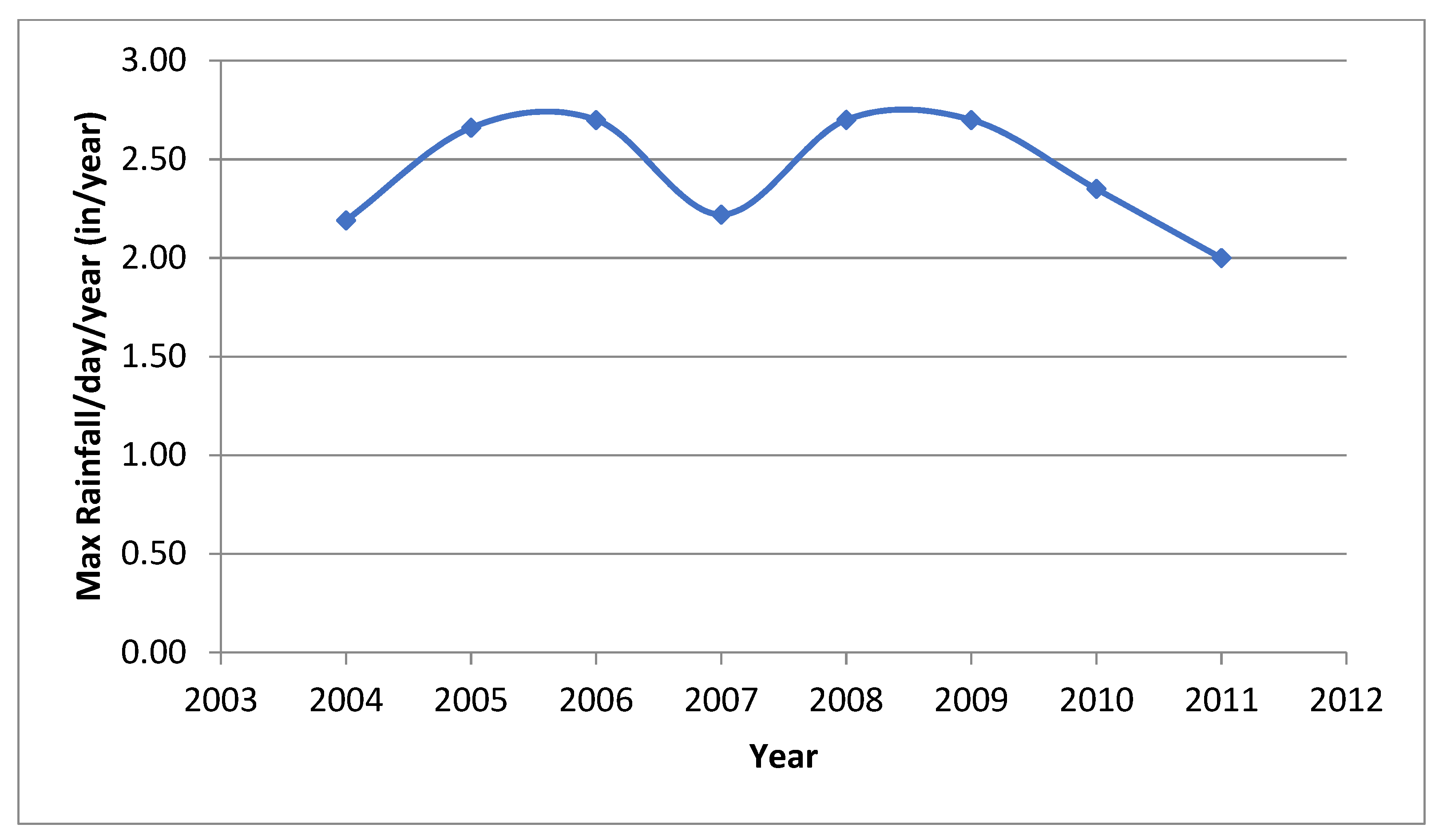
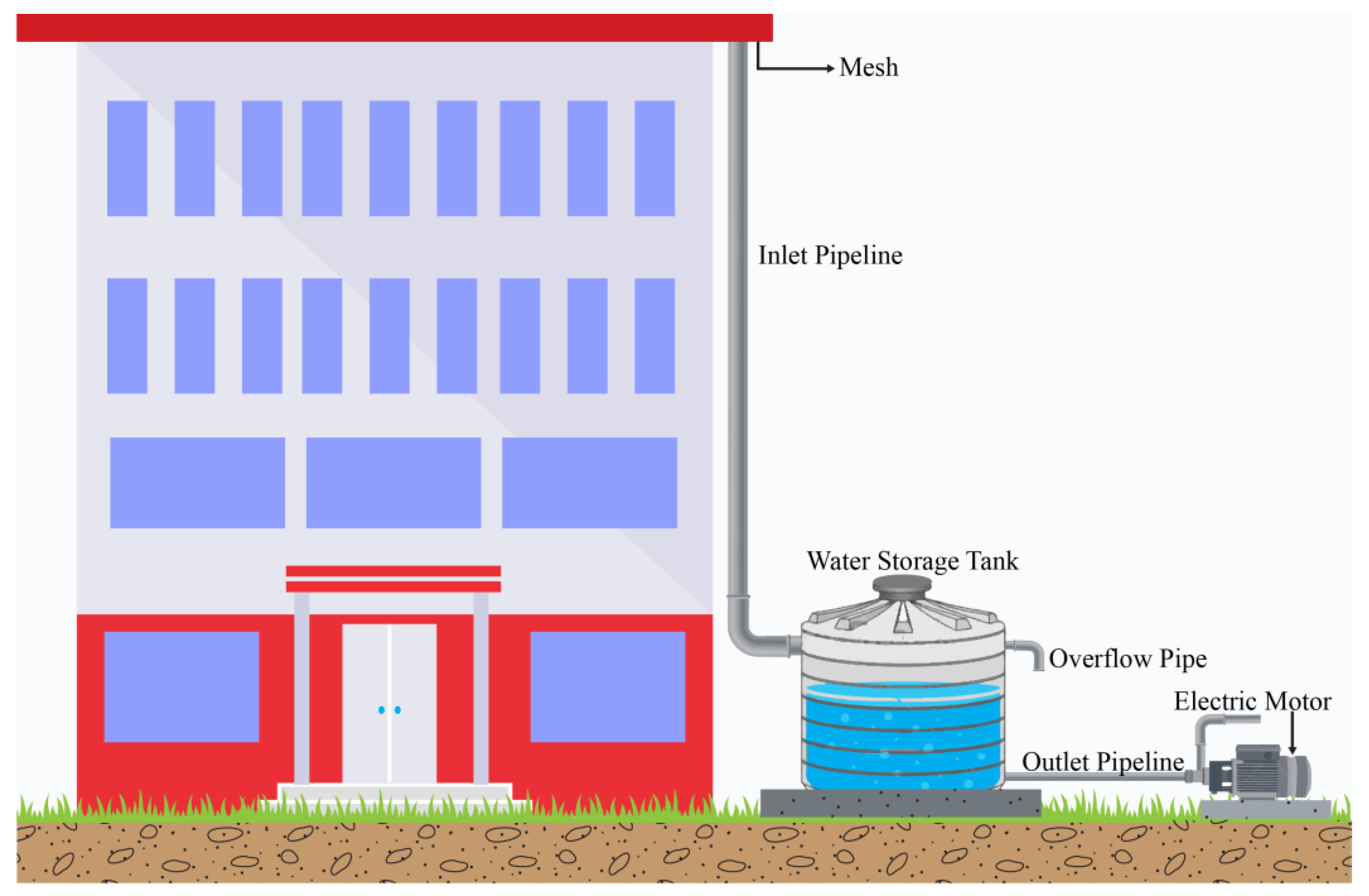

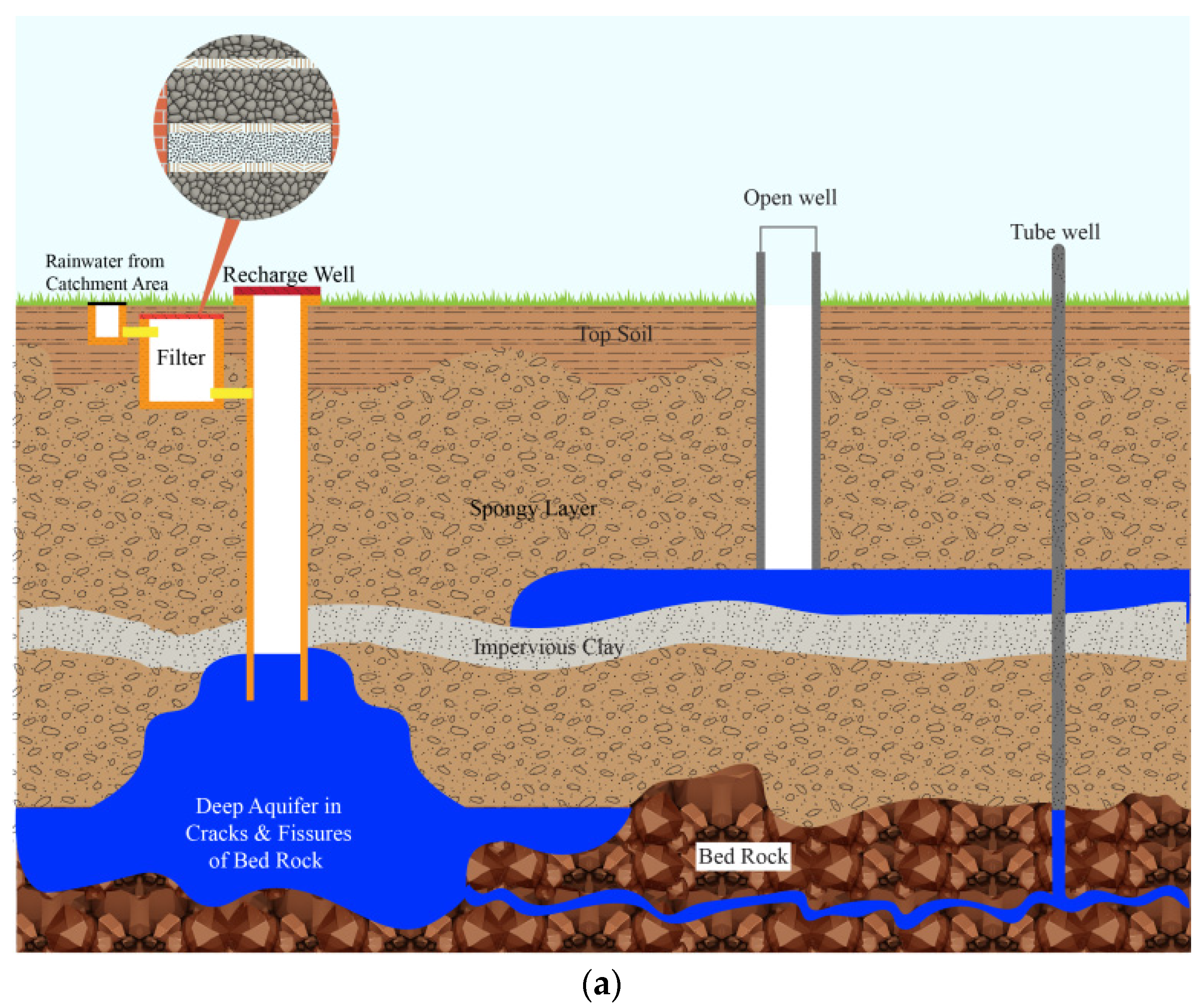
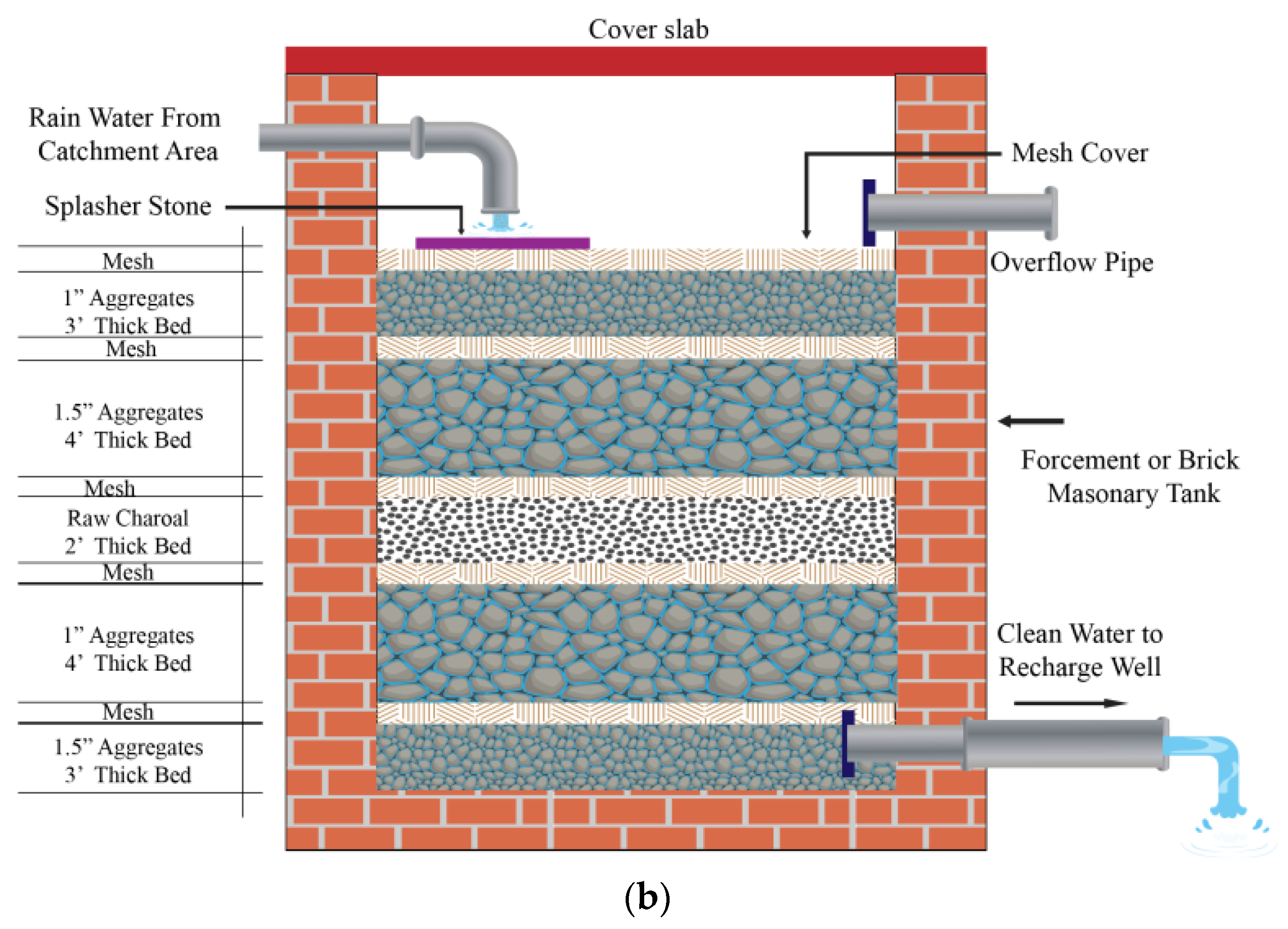



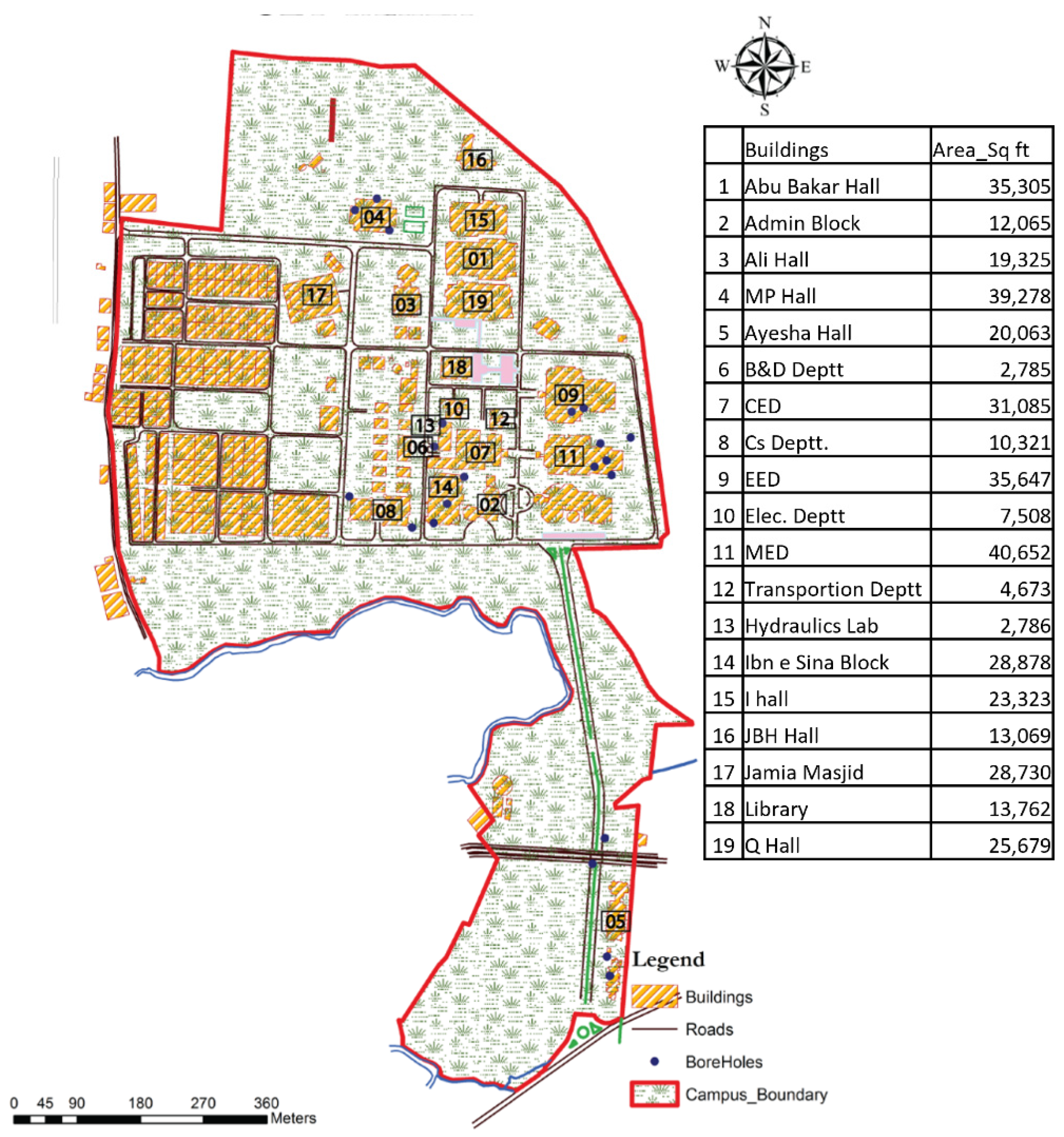
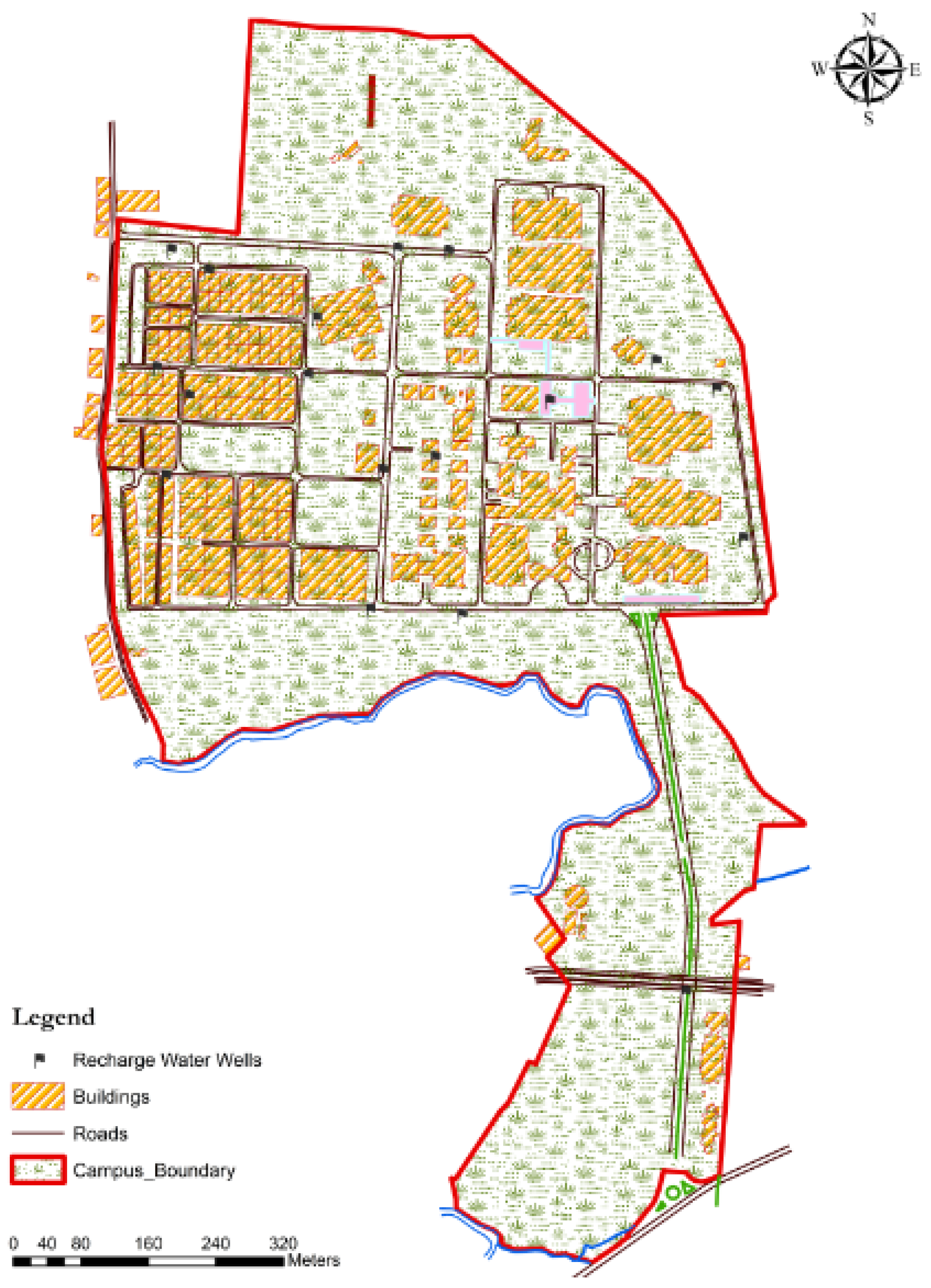
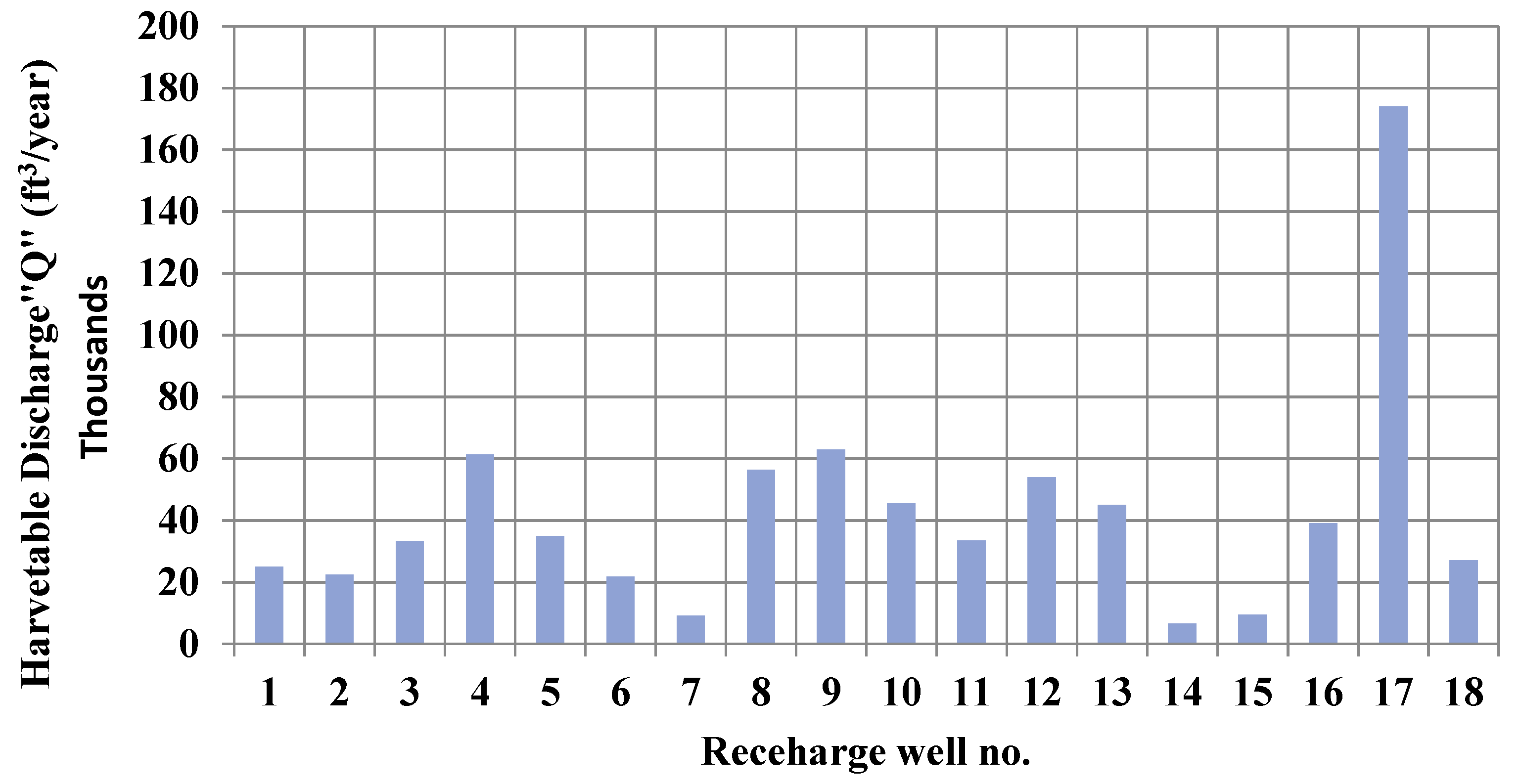
| Sr. No | Soil Type | Coefficient of Permeability (mm/s) |
|---|---|---|
| 1 | Clean gravel | 10+1–10+2 |
| 2 | Coarse and medium sands | 10−2–10+1 |
| 3 | Fine sand, loose silt | 10−4–10−2 |
| 4 | Dense silt, clayey silts | 10−5–10−4 |
| 5 | Silty clay | 10−8–10−5 |
| Depth Upto | Bore Hole No. | Location near by | Type of Soil |
|---|---|---|---|
| 30′ | 1 | Telecom Department | Sandy Silt |
| 30′ | 2 | Telecom Department | Sandy Silt |
| 30′ | 3 | Combined Academic Block | Clay |
| 30′ | 4 | Combined Academic Block | Clay |
| 30′ | 5 | Combined Academic Block | Clay |
| 15′ | 6 | Girls Hostel | Silt |
| 15′ | 7 | Girls Hostel | Silt |
| 30′ | 8 | Overhead Bridge | Silt |
| 30′ | 9 | Overhead Bridge | Silt |
| 30′ | 10 | Industrial Department | Silt |
| 30′ | 11 | Industrial Department | Silt |
| 30′ | 12 | Industrial Department | Silt |
| 30′ | 13 | Industrial Department | Silt |
| 30′ | 14 | Industrial Department | Silt |
| 20′ | 15 | Electrical Department. | Clay |
| 20′ | 16 | Electrical Department | Clay |
| 60′ | 17 | MP Hall | Sillty Clay |
| 30′ | 18 | MP Hall | Silty Clay |
| 50′ | 19 | MP Hall | Silty Clay |
| 20′ | 20 | Hydraulics Lab | Silt |
| 20′ | 21 | Hydraulics Lab | Silt |
Publisher’s Note: MDPI stays neutral with regard to jurisdictional claims in published maps and institutional affiliations. |
© 2022 by the authors. Licensee MDPI, Basel, Switzerland. This article is an open access article distributed under the terms and conditions of the Creative Commons Attribution (CC BY) license (https://creativecommons.org/licenses/by/4.0/).
Share and Cite
Ahmed, A.; Valyrakis, M.; Ghumman, A.R.; Arshad, M.; Pasha, G.A.; Farooq, R.; Janjua, S. Assessing the Rainfall Water Harvesting Potential Using Geographical Information Systems (GIS). CivilEng 2022, 3, 895-908. https://doi.org/10.3390/civileng3040051
Ahmed A, Valyrakis M, Ghumman AR, Arshad M, Pasha GA, Farooq R, Janjua S. Assessing the Rainfall Water Harvesting Potential Using Geographical Information Systems (GIS). CivilEng. 2022; 3(4):895-908. https://doi.org/10.3390/civileng3040051
Chicago/Turabian StyleAhmed, Afzal, Manousos Valyrakis, Abdul Razzaq Ghumman, Muhammad Arshad, Ghufran Ahmed Pasha, Rashid Farooq, and Shahmir Janjua. 2022. "Assessing the Rainfall Water Harvesting Potential Using Geographical Information Systems (GIS)" CivilEng 3, no. 4: 895-908. https://doi.org/10.3390/civileng3040051
APA StyleAhmed, A., Valyrakis, M., Ghumman, A. R., Arshad, M., Pasha, G. A., Farooq, R., & Janjua, S. (2022). Assessing the Rainfall Water Harvesting Potential Using Geographical Information Systems (GIS). CivilEng, 3(4), 895-908. https://doi.org/10.3390/civileng3040051







